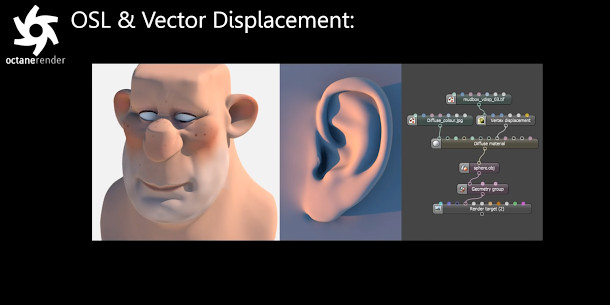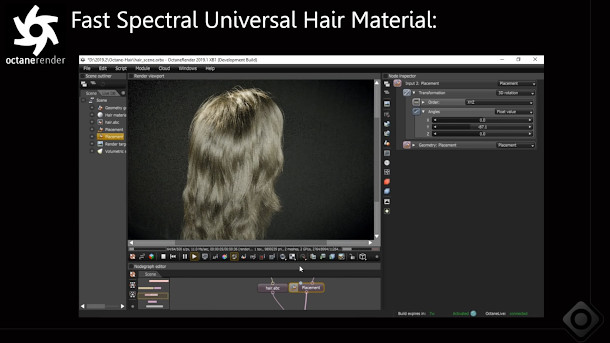Otoy reveals OctaneRender 2019 product roadmap
Otoy has revealed its product roadmap for OctaneRender 2019, this year’s cycle of updates to the GPU production renderer, during a presentation at last week’s GTC 2019 conference.
The firm has also released initial preview versions of both OctaneRender 2019.1 and OctaneRender 2019.2, the first two updates in the cycle.
OctaneRender 2019.1 adds support for layered materials, vector displacement and a rounded edge shader. OctaneRender 2019.2 gets support for hardware-accelerated ray tracing via Nvidia’s RTX architecture.

OctaneRender 2019.1: new layered material system and OSL shading options
New features in OctaneRender 2019.1 include a new layered material system – the GTC slides show car paint, coated glass and thin-wall materials like soap bubbles – with support for up to eight layers.
There are also new Open Shading Language volume shaders, and OSL support for vector displacement: the slides show the classic test case of an ear being generated from a vector displacement map.
In addition, the update adds the rounded edge shader originally due in OctaneRender 3.09 last year.
The edge shader comes with two different modes, Fast and Accurate, the latter of which can be applied only to Convex edges or only to Concave edges to trade render times against visual accuracy.
Other new features include a new universal camera, with support for OSL distortion maps to mimic the properties of real-world camera lenses.
There is also a new AI-driven supersampling system for “4x faster renders”.
You can see comparison images with supersampling on and off at 03:00 in the video at the top of the story: YouTube compression makes it hard to tell for sure, but it seems to cause few changes to rendered ouput.
There has also been a “3x improvement” in the AI volumetric denoiser, though it isn’t clear from the slides whether the figure refers to an improvement in denoising time or visual quality of the output.
Finally, Otoy has added a set of new geometric primitives ranging from standard shapes to complex polyhedra and a truncated cone, shown in use as a light volume.

OctaneRender 2019.2: hardware-accelerated ray tracing on Nvidia GPUs, more Spectron features
New features in OctaneRender 2019.2 include support for hardware-accelerated ray tracing based on Nvidia’s RTX architecture, available in its current-gen Turing GPUs.
In a forum post, Otoy describes enabling RTX hardware acceleration in OctaneRender as providing a speed boost of between 1.1x and 7.5x over rendering using Nvidia’s older CUDA architecture.
Otoy is also continuing to migrate to RNDR, a new universal framework and SDK for all of its technologies, including OctaneRender and its Brigade path tracing engine, its ORBX file format, and light field rendering.
As well as unifying development, the RNDR framework includes new backends for Direct3D, x86 CPUs, and the Vulkan and Metal APIs, enabling OctaneRender to run on a wider range of hardware.
The process was originally due to complete in OctaneRender 2019.1, but Otoy’s GDC slides include one showing headless OctaneRender “finally” running on macOS in 2019.2.
The release also includes more functionality in Spectron, the new procedural volumetric lighting system announced last year, and partially implemented in OctaneRender 2018.1.
Features held over to 2019.2 include support for fluorescence, phosphorescence and polarised light.
The update will also introduce random walk subsurface scattering – also recently added in Arnold – and a “fast spectral universal hair material”.
However, one previously announced feature – it was originally scheduled for OctaneRender 2018.1 – that doesn’t feature anywhere in the new roadmap is the anime kernel: a non-photorealistic rendering system.
Availability and system requirements
OctaneRender 2019.1 and 2019.2 are both available as public previews: OctaneRender 2019.1 XB1 includes all of the features listed above; the OctaneRender 2019.2 preview only features the RTX acceleration.
The software is available for 64-bit Windows 7+, Linux and macOS 10.12+.
Otoy hasn’t announced final release dates for either version, but in the past two release cycles, it has taken four to six months to go from an initial XB1 release to a stable build.
Pricing and future subscription plans
OctaneRender currently costs $619 for a perpetual licence of the standalone renderer plus one DCC integration plugin. Further plugins cost between $139 and $269 each; render nodes cost $399 each.
An Enterprise subscription costs $699, including a perpetual licence of the standalone edition, plus 12 months’ access to all of the integration plugins and updates.
At the time of posting, the version of OctaneRender available in Otoy’s online store is OctaneRender 4: the stable version of OctaneRender 2018.1 is available, but only as an update.
Otoy has said that it is considering a “limited rent-to-own model” making it possible to buy OctaneRender 2018.1 outright, rather than as part of a subscription.
In its online FAQs, the firm says that it will announce more details in “Q1 2019” along with more details of a free two-GPU version of OctaneRender 4, announced last March, but still not currently available.
Read a full list of new features in OctaneRender 2019.1 XB1
Read a full list of new features in the public preview of OctaneRender 2019.2
